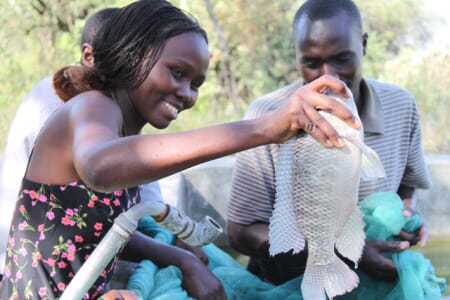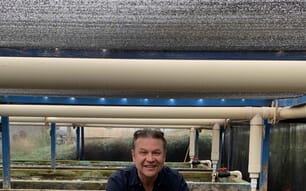With no background in aquaculture, Mr Archer moved to Africa over 10 years ago, pursuing a career in property development. However after the collapse of the markets, he teamed up with an old friend, Perrie Hennessy, and with the expertise of Dr Bonnie Dunbar, a professor at the University of Nairobi and Nick Justus, set up Omega Farms.
With a current shortage of tilapia fingerlings on the market in Kenya and ideal breeding conditions at Lake Baringo, the four directors saw an opportunity that couldn't be missed.

Lake Baringo
The farm is based on and around the Island of Ol Kokwe on Lake Baringo.
"The optimum temperature for breeding tilapia is 28-31 degrees Celsius," explained Mr Archer. "And this just so happens to be the temperature of Lake Baringo - making it the perfect location to set up a tilapia breeding station."
On top of this, Lake Baringo has its own species of tilapia. Mr Archer explained that despite the lake being small (10km by 20km), there is an endemic species of tilapia in the lake.
Mr Archer explained that land cannot be bought in Africa, a lot of time was spent negotiating a lease for Omega Farms with the local community. The agreement gives Omega Farms the land it needs and in return promises a rental income and also employment for locals.
Shortage of tilapia fingerlings
The initial aim of the project is to produce tilapia fingerlings to sell to local fish farmers.
Over the last few years there has been a massive drive by the Kenyan government to increase aquaculture production, explained Mr Archer. Over 28,000 fish ponds have been established with the help of government grants. However, the government didn't account for the supply of tilapia fingerlings to populate the ponds, and subsequently there has been a significant shortage of stock in Kenya.
"Ponds require restocking every eight to nine months, and despite a large tilapia breeding station in the West, there is just not enough fingerlings to stock ponds, which is where Omega Farms will help," said Mr Archer.

Breeding facility
A breeding facility of 20 concrete tanks, each holding 66,000 litres of water, have been built on the island and filled.
The farm is taking broodstock from the lake. "We don't want to introduce any other species to the lake," said Mr Archer. "The endemic species has adapted itself to survive in the lake, making it the best we could ask for."
Initially the team at Omega had to determine whether the local breed of tilapia grew out to a marketable size. They established that a fish of two inches would grow to a length of 13 inches within five months. So far Omega Farms has around 1,000 broodstock, they are aiming to collect 6,000 by the end of the year.
To obtain the broodstock the farm is paying local fishermen. The fishermen will get paid after the stock caught have survived five days in captivity.
Initially individual fishermen were bringing in broodstock, which was creating problems on the farm. Now, Mr Archer explained that groups of fishermen are bringing in over 200 broodstock at a time.
Once fully set up, Omega Farms are looking at producing six million fingerlings a year (500,000 a month). Mr Archer said that individual farmers are looking at purchasing one to two thousand a time. He also said that in some cases the Ministry of Fisheries will be buying stock for some ponds.
Despite not currently have stock to sell, Omega Farms has already taken some orders. The farm is hoping to supply tilapia within a 200km radius of Lake Baringo.

Duckweed
A laboratory is also in the process of being built. It is hoped that research from the lab will aid the farm in finding the correct diet for the endemic species of tilapia.
Duckweed provides high levels of protein, which in turn increases the omega 3 in the fish once digested.
Research at the lab will look at how to dry the duckweed without sacrificing this protein content and how to include it alongside other fish feed at the right ratio.
Mr Archer said that many of the fish feeds currently marketed are short of the protein required - the level of supervision of standards is very different in Africa than Europe.
The research on duckweed is being conducted by Dr Dunbar and students from the University of Nairobi.
The future
Over US$350,000 has been invested in Omega Farms so far. Building on an island doubles the cost of production, said Mr Archer.
The farm has already invested in floating hapa cages on the Lake. The long term plan is for the farm to grow out tilapia in these cages.
However for now the main focus remains on establishing the breeding tanks, and maintaining a supply of tilapia fingerlings.



